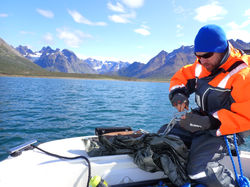
MARINE MIGRATIONS AND AREA USE OF ARCTIC CHARR IN SOUTH-WESTERN GREENLAND
Project Partners: Lead – Jan Davidsen (Norwegian technical university NTNU) supported by Adam Piper (Institute of Zoology) and collaborators from Dalhousie University, University of Waterloo, Swiss Federal Institute of Aquatic Science & Technology.
Location: Greenland
Arctic aquatic ecosystems are highly vulnerable to anthropogenic disturbances and potentially to ongoing climate change. Climatic changes are most pronounced in Arctic and subarctic areas, where increases in temperature and precipitation exceed global averages, resulting in an extension of the annual growth period.
Since migration is an adaptive response to particular conditions, these changes will potentially alter the selective pressures on movement behaviour. The environmental changes may also interfere with or disrupt a species’ ability to migrate. In either case, environmental changes could lead to the reduction or total loss of a migration, yet we have little understanding of when to expect these outcomes to occur. Within arctic freshwater systems, Arctic charr (Salvelinus alpinus) are often the only fish species found, and as the top predator can provide valuable information about the status and functioning of Arctic aquatic ecosystems.
In a freshwater lake and fjord system in Southwestern Greenland, we are combining acoustic fish tracking techniques with physiological, genetic and environmental data to better understand the variation in migratory tactics and the extent of marine habitat use of Arctic charr. The findings will help provide an evidence base for resource managers to protect different Charr ecotypes in the face of global environmental change as well as further our knowledge on the functioning of Arctic freshwater and marine systems.
 |  |  |  |  |
|---|---|---|---|---|
 |  |  |  |  |
 |  |  |